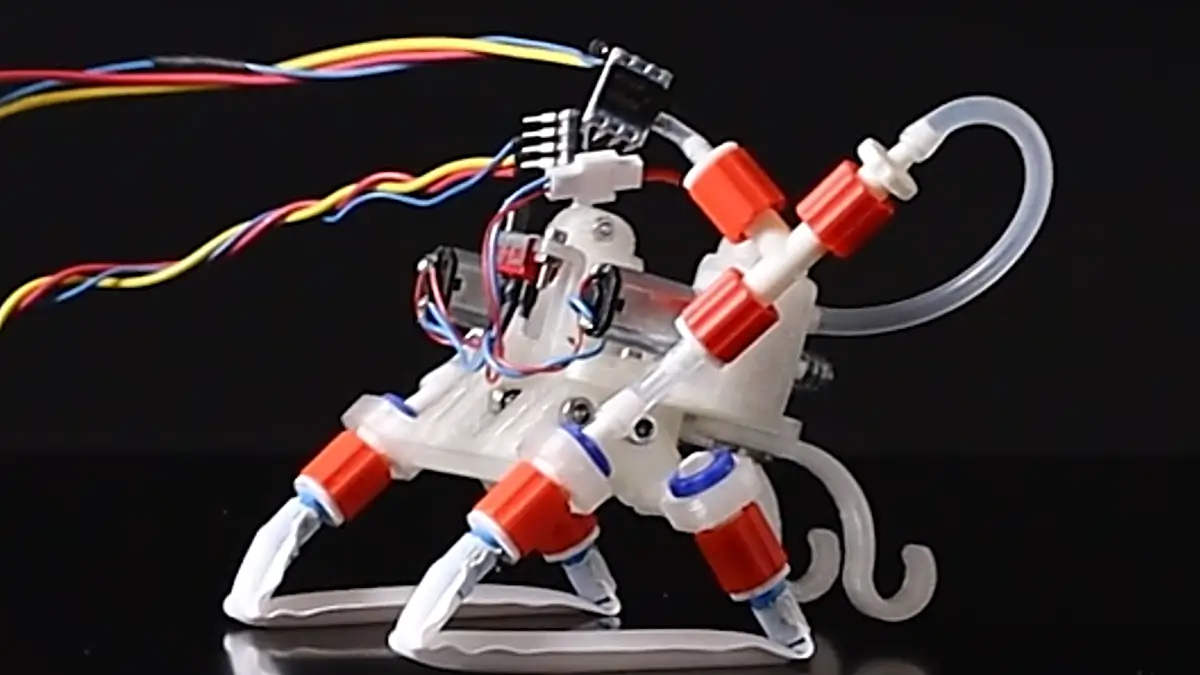The contribution without “brain”: Robot moves independently by Felix Baumann using a compressed air on Basic Thinking. You always stay up to date with our newsletter.

Dutch researchers have developed an air -powered robot that is only moving using compressed air. The system manages without chips and without control.
A team of researchers from the Dutch Amolf Institute an air -powered robot Developed that works without a central control unit. Instead of chips, processors or engines, it only uses compressed air and elastic materials to move on to their way.
The basis is a system of flexible tubes that pass on regular movements when the air is added. These so -called “self -oscillating limbs” are deformed in a kind of wave pattern that walks along the tubes. This creates step movements that move the robot forward – without electronic commands.
The function is based on simple physical dynamics: if air is led through the elastic tube, a kink is created at one point. This kink changes the air flow, which in turn influences the position and expression of the next kink point. The system regulates itself and creates a rhythmic movement process.
Air -powered robot: autonomy through compressed air and material
Several of these limbs can automatically synchronize with each other, so that a coordinated locomotion is created. The air-powered robot should be able to reach movement frequencies of up to 300 Hertz and, according to the researchers, moves faster than comparable soft robot with electronics.
It seems noteworthy that the robot is able to react to external stimuli – for example to obstacles, changes in the underground or even on light sources. He independently changes his movement pattern without a program having this change. The researchers speak of “physical intelligence”, in which the movement is not created by computing power, but solely by the interaction of materials and the surrounding area.
Use for environmental surveillance
Such systems could in future be used in areas where simple, reliable technologies are required. Examples include environmental surveillance, use in search and rescue operations or in sensitive medical environments.
The complete independence of electronics makes the air -powered robot particularly robust compared to disorders, moisture or electromagnetic influences. This technology also opens up new possibilities for use in remote regions without infrastructure or under extreme conditions.
Also interesting:
- The energy consumption of Chatgpt: per day, per month – and per year
- AI from Europe: Everything you need to know about the Mistral-Ki “Le Chat”
- Study reveals: How efficient are heat pumps really?
- Lithium iron phosphate batteries: This is how LFP batteries work
The contribution without “brain”: Robot moves independently by Felix Baumann using a compressed air on Basic Thinking. Follow us too Google News and Flipboard.
As a Tech Industry expert, I find the concept of a robot moving independently without a “brain” fascinating yet concerning. While using compressed air to power the robot’s movements is innovative and potentially efficient, the lack of a central control unit raises questions about the robot’s ability to make informed decisions and navigate its surroundings effectively.
Without a “brain” to process sensory input and make calculated decisions, the robot may struggle to adapt to changing environments or unforeseen obstacles. This could limit its practical applications and overall effectiveness in real-world scenarios.
Additionally, the reliance on compressed air for movement raises concerns about the robot’s energy efficiency and sustainability. While air-powered robots may offer certain advantages in terms of simplicity and cost-effectiveness, they may also be limited in their range and endurance compared to more traditional robotic systems.
Overall, while the concept of a brainless robot powered by compressed air is intriguing, it may face significant challenges in terms of functionality, adaptability, and energy efficiency in practical applications. Further research and development will be needed to address these issues and unlock the full potential of this technology.
Credits